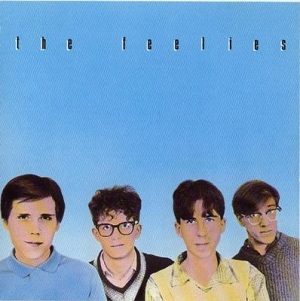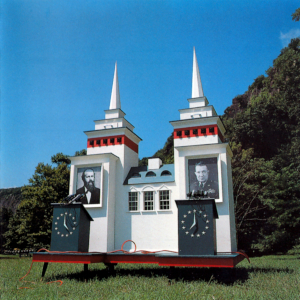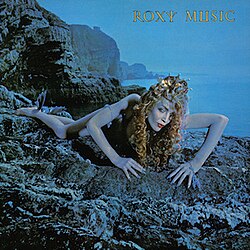“Why are guys so into LCD Soundsystem?” my friend, the musician/DJ Bonnie Jeanne asked me the other day. Normally, I would take this comment as something more biting than it probably reads on the page, something more like: “Why do guys like this basic bitch band that isn’t nearly as good as these 15 other more obscure acts that me and all my cool girlfriends like? Why is your taste – and the taste of all men – so jejune? When you order at a drive-through do they reflexively serve your drink in a sippy cup?” Bonnie and I have had this argument many times over our friendship. But this time I didn’t take the bait. I actually considered my answer.
Not all men like LCD Soundsystem, but of my cohort Indie Rock Boys, a damn fine chunk of them not only like the band, but probably, at one point, considered it their favorite. It’s in describing “my cohort” where I’ll probably start hurting my own feelings. Broadly, it’s straight, white men who are good at reading and bad at sports. In the early ‘90s they were into grunge. In the late ‘90s they were into indie rock. And in the 2000s they were having a bit of an identity crisis.
I should point out that in a pre-social media era, people didn’t have an online canvas with which to express their personality and interests, so they relied on describing which bands they liked, which bands they didn’t like, and wearing or not wearing Big Johnson t-shirts (Google them). It seems stupid now – and it was stupid then – but it was really important that you not get caught admitting to liking the “wrong” band, otherwise some stranger might get the wrong impression of you. See, if someone caught you listening to Linkin Park, it meant you didn’t read Gravity’s Rainbow. (I’m kidding, of course. No one has read Gravity’s Rainbow.)
In the 1990s, these tweedy indoor kids were into guitar rock, and pretty much exclusively guitar rock, because other types of music were either “gay” or “for girls.” (You know, you live by the prejudices of the patriarchy even if you’re not on the alpha tier.) However, by the 2000s, indie rock was evolving to include non-string instruments like synthesizers, and some artists were even eschewing drums for samplers and sequencers. Hell, even indie guitar monarchs Radiohead made the six-string play second fiddle to discordant washes of reverb and nervous synthesizers for their fin de siècle Kid A.
There was also the matter that the hippest bands of the era (Yeah Yeah Yeahs, Bloc Party, TV on the Radio, Le Tigre) were blacker and gayer and womanier than your Pavements, Polvos, and Pixies of the ‘90s. And even the white boys with guitars (Franz Ferdinand, The Strokes) were suddenly dressing better than the t-shirt and blue jean warriors of the ‘90s.
The fact of the matter is that if you had a stock figure in the Indie Rock Boy character selection screen, he would’ve looked very similar from 1990 to 2002. But by 2005, he would’ve evolved something new, and his tastes would’ve evolved as well. He just needed an ambassador to help connect the dots from Dinosaur Jr. to Daft Punk.
Enter James Murphy.
Murphy spent his twenties in the 1990s as an NYC scenester, playing in rock bands, recording others’ music, and, presumably, living the life of every other Indie Rock Boy. Then a wonderful thing happened: he got into drugs.
Murphy discusses taking ecstasy at a rave in Lizzy Goodman’s Meet Me in the Bathroom: Rebirth and Rock and Roll in New York City 2001-2011: “I was dancing and I was happy and I had a revelation: this is actually me. I was fully me.”
This was a big moment for ‘90s Indie Rock Boys, though its ramifications wouldn’t be felt until the next decade. See, in the ‘90, indie audiences didn’t enjoy music so much as appreciate it. Music could be clever, it could rock, it could be ear-blisteringly loud, it could be wrist-slittingly sad, but it could not be funky, white boy. The archetype of the immobile music fan with his arms crossed while he examines a band was the default mode of ‘90s Indie Rock Boy at a concert.
It took one of their own, James Murphy, to convince them that it’s okay to shake their asses, move their feet, and crack a smile once in a while.
Although he often looks like he just got out of bed, Murphy is actually pretty Type A. In my experience, this is true of most band leaders, but it seems especially true of Murphy, who produces, typically mixes, and plays many of the instruments on is own records, which, of course, sound immaculate. Something of a polymath, before LCD Soundsystem, Murphy mostly operated behind the scenes as a producer, engineer, and, eventually, as the owner of the label DFA. And then he started releasing his own music.
Murphy’s first single as LCD Soundsystem “Losing My Edge” came out in 2002 when he was 32 years old. It’s nearly eight dancy minutes of an Indie Rock Boy having a midlife crisis. Over a slamming beat, an aging DJ laments that younger, “better-looking people with better ideas and more talent,” who’re “actually really, really nice,” are spinning the same hip classics that he has spent his life curating, making him feel obsolete. He comments on an evolving music scene in which electronic musicians are tossing their PCs for arpeggiators and samplers, and guitarists and turntablists are swapping instruments. And then he lists his record collection.
It’s an alternative canon smorgasbord that includes Nuggets-era garage rock, mutant disco, post punk, no wave, golden era hip hop, hardcore, Detroit techno, ‘60s obscuro, noise rock, free jazz, and Gil. Scott. Heron. This list not only proved Murphy’s bonafides as an elite crate-digger, it gave a map to the “the kids [who were] coming up behind” him.
It also gave Indie Rock Boys, who were already down with half the list (Lou Reed, Can, Pere Ubu), a whole new world of electronic, new wave, and dance music to explore. “Maybe,” they figured, “this music for girls and gays is okay as long as the our nerd king says so.”
Three years later, LCD Soundsystem released their self-titled debut (which appends their early singles including “Losing My Edge” on a second disc). LCD Soundsystem distills down the best sounds of Murphy’s record collection, and puts it in a wry, dancable, Indie Rock Boy-friendly collection.
Murphy and this band would go both harder (“North American Scum”) and softer (“New York, I Love You but You’re Bringing Me Down”) on 2007’s Sound of Silver, and would release their most complete album with 2010’s This is Happening, have a blowout retirement show at Madison Square Garden in 2011, and then return in 2017 with the more subdued, but mostly the same American Dream. Earlier this year they announced a 2025 tour and a forthcoming album. Their newest single “X-Ray Eyes” could’ve come out on their first album.
But the damage had been done by 2005. Indie Rock Boys had become Indie Rock Men. From there they would either get really into Renaissance-era history, craft beer and bicycles, or cocaine, bisexuality and face glitter. Both groups would later get really vocal about polyamory, but that’s a story for another time. Importantly, they would realize that rock music history wasn’t just a string of white guitar dudes with increasingly heavy distortion pedals, it was a patchwork of races, girls and gays, playing instruments as varied as their backgrounds. They just needed a schlubby guy in a t-shirt to introduce them to it.
And that, Bonnie, is why guys like LCD Soundsystem. It opened their eyes, ears, and hearts. Say something smarmy back to me now.







